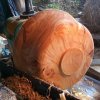- Joined
- Apr 1, 2015
- Messages
- 603
- Likes
- 450
- Location
- Sitka, Alaska, United States
- Website
- www.zachlaperriere.com
Does anyone out there pond (soak in water) their bowl stock?
20 years ago I took a few carving classes with a Tsimshian (Alaska native) master carver who always ponded his spoon stock for a year or two. It made the alder a rich brown color. Carving it was amazing, and the end spoons were perhaps harder.
I just turned some alder bowl stock I had ponded for a year. After removing it from the fresh water, I let it dry for about two weeks and then rough turned it after the moisture dropped back down to green levels. In the end, the alder no longer stained red as all green (freshly cut) alder does. I didn't end up with a rich brown color, instead just a a little tint of brown. I'm thinking because I soaked whole logs, not rough turned bowls. Oh well. One interesting highlight was that stress wood around knots stayed completely white. Here's a picture of a roughed profile that shows the different colors.

I haven't seen much on ponding outside of timber preparations. The main reasons for ponding timbers was release of internal stresses, better workability, and potential increased strength. So far I can't say much more beyond the alder cut beautifully. I'll know more in a few months when the blanks are dry.
Next experiment I have a bunch of semi-green alder I'm thinking of rough turning then ponding for another year or two. I have noticed a difference in the cutting of w. hemlock versus hemlock that been in the ocean a while. Still experimenting with stock from beaches.
If anyone has experience with ponding bowl stock, I'd love to hear it!
Zach
20 years ago I took a few carving classes with a Tsimshian (Alaska native) master carver who always ponded his spoon stock for a year or two. It made the alder a rich brown color. Carving it was amazing, and the end spoons were perhaps harder.
I just turned some alder bowl stock I had ponded for a year. After removing it from the fresh water, I let it dry for about two weeks and then rough turned it after the moisture dropped back down to green levels. In the end, the alder no longer stained red as all green (freshly cut) alder does. I didn't end up with a rich brown color, instead just a a little tint of brown. I'm thinking because I soaked whole logs, not rough turned bowls. Oh well. One interesting highlight was that stress wood around knots stayed completely white. Here's a picture of a roughed profile that shows the different colors.

I haven't seen much on ponding outside of timber preparations. The main reasons for ponding timbers was release of internal stresses, better workability, and potential increased strength. So far I can't say much more beyond the alder cut beautifully. I'll know more in a few months when the blanks are dry.
Next experiment I have a bunch of semi-green alder I'm thinking of rough turning then ponding for another year or two. I have noticed a difference in the cutting of w. hemlock versus hemlock that been in the ocean a while. Still experimenting with stock from beaches.
If anyone has experience with ponding bowl stock, I'd love to hear it!
Zach
